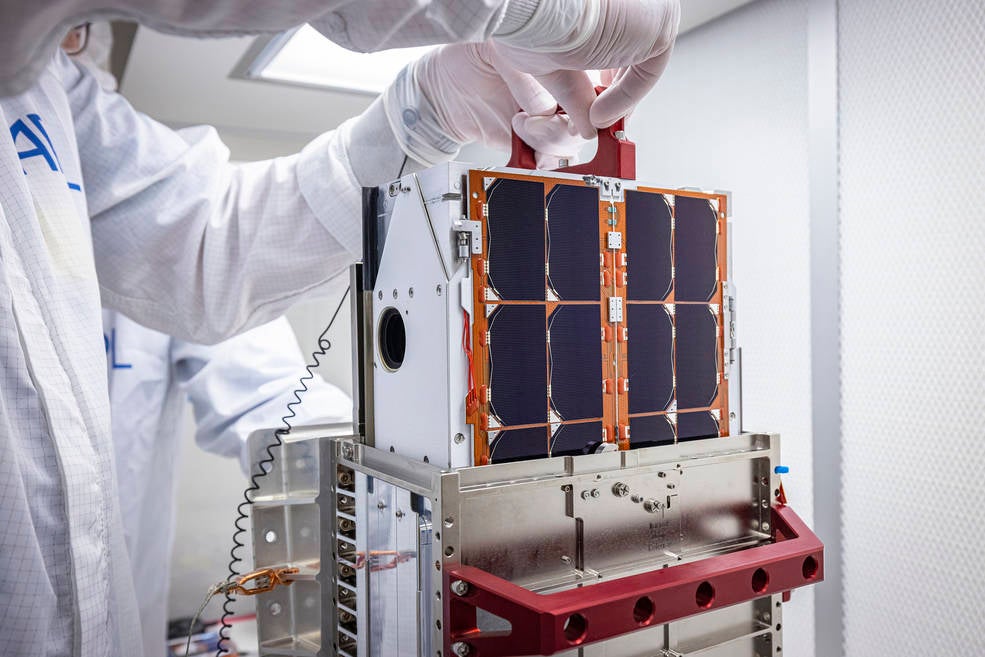DART won’t survive its mission to deflect an asteroid, but the recently deployed LICIACube — a tiny probe equipped with cameras — will document the encounter in gory detail.
NASA’s Double Asteroid Redirection Test (DART) is the space agency’s first demonstration of a defence strategy to protect against threatening asteroids. The 624 kg spacecraft is scheduled to smash into Dimorphos — the junior member of the Didymos binary asteroid system — on September 27 at 9:14 a.m. AEST. Dimorphos poses no threat to Earth, but the experiment, should it work, will slightly nudge the moonlet from its current trajectory. In the future, a similar strategy could be used to deflect a genuinely threatening asteroid.
DART will not survive the encounter, but its onboard camera, called DRACO (Didymos Reconnaissance and Asteroid Camera for Optical navigation), will provide a first-person perspective of the collision. Nearby, LICIACube (pronounced LEE-cha-cube) will use its two onboard cameras to document the impact and its aftermath.

Controllers issued a command on September 12 for DART to release the 14-kilogram LICIACube, which it had been carrying since its launch on November 24, 2021. A signal confirming the deployment arrived one hour later, much to the delight of Simone Pirrotta, LICIACube project manager for the Italian Space Agency.
“We are so excited for this — the first time an Italian team is operating its national spacecraft in deep space,” he said in a statement. “The whole team is fully involved in the activities, monitoring the satellite status and preparing the approaching phase to the asteroid’s flyby.”
LICIACube, short for Light Italian CubeSat for Imaging Asteroids, was designed and built by Argotec, an Italian aerospace company, with contributions from the National Institute of Astrophysics and the Universities of Bologna and Milan. The tiny probe — built from a 6-unit cubesat bus — is equipped with two optical cameras, named LUKE (LICIACube Unit Key Explorer) and LEIA (LICIACube Explorer Imaging for Asteroid). Together, LUKE and LEIA will collect data to confirm the success of the DART mission and to inform future models of similar tests done with kinetic impactors.
Pirrotta and his colleagues are currently calibrating LICIACube by capturing dynamic images of distant celestial bodies. The tiny probe will receive a series of manoeuvring commands just prior to DART’s fatal rendezvous with the 158.50 m-wide Dimorphos. NASA’s spacecraft, travelling at speeds reaching 24,140 km per hour, will be annihilated by the impact. LICIACube will travel past the asteroid roughly three minutes after the encounter to confirm the impact, document the spread of the resulting dust plume, attempt to capture an image of the newly formed crater, and document the opposite side of Dimorphos, which DART will never see.
“We expect to receive the first full-frame images and to process them a couple of days after DART’s impact,” Pirrotta said. We’ll then use them to confirm impact and to add relevant information about the generated plume — the real precious value of our photos.”
By looking at the debris plume and impact crater, scientists hope to gain a better understanding of the asteroid’s structure and surface material. Observations of Dimorphos’s non-impacted hemisphere will improve estimates of the moonlet’s dimensions and volume.
NASA and ESA are planning to document the impact from afar. DART, should it be successful, will alter the speed of Dimorphos in its orbit around the 807.72 m-wide Didymos “by a fraction of one per cent, but this will change the orbital period of the moonlet by several minutes — enough to be observed and measured using telescopes on Earth,” according to NASA. Didymos is roughly 1.2 km from its larger companion.
Approximately 28,000 near-Earth asteroids have been documented over the years, with roughly 3,000 discoveries made each year. None of these known asteroids pose a risk to us within the next 100 years, but the chance exists that a threatening asteroid will suddenly come into view. The DART test, should it succeed, could equip us with a valuable strategy for mitigating these existential risks.
Related: NASA’s Upgraded Impact Monitoring System Could Prevent an Asteroid Apocalypse.
